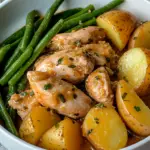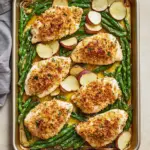This vibrant medley of roasted potatoes, carrots, and zucchini not only looks appealing but is also packed with flavor and nutrients. The caramelization of the vegetables enhances their natural sweetness, while the herbs add depth and aroma, making this dish a perfect addition to any meal.
Whether you’re serving it as a side for a festive dinner or a weeknight family meal, this colorful roasted vegetable dish is sure to impress. Feel free to customize it with your favorite herbs and spices, or toss in other seasonal vegetables for variety. Enjoy the beautiful colors and fresh flavors that make this dish a standout on any table.
Full Recipe:
Ingredients:
- 2 cups baby potatoes, halved
- 2 cups carrots, sliced
- 2 cups zucchini, sliced
- 3 tablespoons olive oil
- 2 teaspoons dried thyme
- 2 teaspoons garlic powder
- Salt and pepper to taste
- Fresh parsley, chopped (for garnish)
Directions:
- Preheat the oven to 400°F (200°C).
- In a large bowl, combine baby potatoes, sliced carrots, and zucchini. Drizzle with olive oil and sprinkle with thyme, garlic powder, salt, and pepper. Toss until evenly coated.
- Spread the vegetables in a single layer on a large baking sheet.
- Roast in the preheated oven for 25-30 minutes or until the vegetables are tender and lightly browned, stirring halfway through.
- Once done, remove from the oven and garnish with fresh parsley before serving.
Prep Time: 15 minutes | Cooking Time: 30 minutes | Total Time: 45 minutes
Kcal: 180 kcal | Servings: 4 servings
Origin:
- Brussels Sprouts: These mini cabbage-like vegetables are native to the Mediterranean region and have been cultivated for over 800 years. Their name comes from Brussels, Belgium, where they became popular in the 16th century. Brussels sprouts thrive in cooler climates and are often associated with fall and winter dishes.
- Balsamic Vinegar: Authentic balsamic vinegar hails from Modena and Reggio Emilia in Italy. It’s made from grape must (unfermented juice) and aged in wooden barrels for up to 25 years. Traditional balsamic vinegar is a prized, gourmet ingredient, but more commonly available varieties (aceto balsamico di Modena) are less expensive and suitable for everyday cooking.
Cooking Tips for Roasting Vegetables:
- Uniform Sizing: Ensure your vegetables, whether they are Brussels sprouts, carrots, or any other type, are cut into uniform pieces. This guarantees even cooking and prevents some pieces from burning while others are undercooked.
- Preheat Your Oven: A preheated oven ensures that the vegetables start roasting right away, which helps them caramelize better, leading to a crisp exterior and tender interior. Use a temperature around 400°F (200°C) for optimal results.
- Don’t Overcrowd the Pan: When roasting vegetables, make sure they are spread out in a single layer on the baking sheet. Overcrowding the pan traps steam and leads to soggier vegetables instead of the crispy, caramelized texture you’re aiming for.
- Flip Vegetables Midway: Stirring or flipping the vegetables halfway through the cooking process allows for even browning on all sides. This is particularly important for vegetables like Brussels sprouts, which can get a little too brown on one side if left unattended.
- Balancing Sweetness and Acidity: Combining balsamic vinegar with honey or maple syrup is an excellent way to balance acidity with sweetness. The sugar content helps the vegetables develop a glaze, especially when roasted at high temperatures. The balsamic’s acidity also cuts through the richness of the vegetables, giving a perfect flavor balance.
Other Important Information:
- Nutritional Benefits:
- Brussels Sprouts: They’re high in vitamins C and K, fiber, and folate. Eating cruciferous vegetables like Brussels sprouts may reduce inflammation and improve heart health.
- Carrots: Rich in beta-carotene (vitamin A), carrots are excellent for eye health and skin.
- Olive Oil: Using extra virgin olive oil is a healthy fat source that adds richness without overwhelming the dish.
- Best Time to Serve: Roasted vegetable dishes like this are perfect for fall and winter when Brussels sprouts and root vegetables are in season. The warmth and flavor of roasted veggies make them a great side for holiday meals or cozy weeknight dinners.
- Pairing Suggestions:
- These balsamic roasted vegetables pair wonderfully with roasted meats like chicken, pork, or beef.
- They can also be served as part of a vegetarian or vegan meal, alongside grains like quinoa or wild rice for a wholesome, nutrient-rich dish.
- How to Store Leftovers:
- Store leftover roasted vegetables in an airtight container in the fridge for up to 3-4 days.
- You can also reheat them in the oven to restore their crispy texture, as microwaving can make them a bit soggy.
Varieties of Brussels Sprouts:
-
- While the green Brussels sprouts are the most common, they also come in a purple variety, which offers a slightly sweeter taste and a unique appearance. Additionally, there are heirloom varieties, like the “Long Island Improved,” which are bred for better flavor and hardiness.
Nutrition Facts:
-
- Brussels sprouts are incredibly nutrient-dense, offering high levels of fiber, vitamins C and K, and antioxidants. A cup of cooked Brussels sprouts contains about:
- 56 calories
- 4 grams of protein
- 11 grams of carbohydrates
- 4 grams of fiber
- They are also a good source of omega-3 fatty acids, which are important for heart health.
- Brussels sprouts are incredibly nutrient-dense, offering high levels of fiber, vitamins C and K, and antioxidants. A cup of cooked Brussels sprouts contains about:
Flavor Profile:
-
-
-
- When cooked, Brussels sprouts develop a nutty, slightly sweet flavor. However, if overcooked, they can take on a bitter taste due to the breakdown of sulfur compounds. This is why roasting or sautéing them is preferred, as these methods enhance their natural sweetness and minimize bitterness.
-
-
Cooking Techniques
- Using High Heat:
- Roasting at a high temperature (around 400°F to 425°F) is essential for achieving that crispy exterior. If you want extra crispiness, consider broiling the vegetables for a couple of minutes at the end of the cooking time, but keep a close watch to prevent burning.
- Adding Flavor Enhancers:
- You can enhance roasted vegetables by adding different herbs and spices. For example, rosemary, sage, or smoked paprika can introduce new flavor profiles. Citrus zest (like lemon or orange) can also be sprinkled after roasting for a fresh, bright finish.
- Cooking with Other Ingredients:
- Consider adding other ingredients to your roasting pan, such as garlic cloves, red onions, or even nuts (like walnuts or almonds) for added flavor and texture. These can roast alongside your vegetables, enriching the dish.
Storage and Reheating Techniques
- Freezing Roasted Vegetables:
- If you want to store roasted vegetables for an extended period, consider freezing them. Allow them to cool completely, then place them in freezer bags or airtight containers. They can last up to three months. To reheat, roast them from frozen at 425°F for about 15-20 minutes to regain crispiness.
- Creating a Meal Prep Strategy:
- Roasted vegetables can be made in large batches and used throughout the week. They can be added to salads, grain bowls, or served as a side dish. This approach not only saves time but ensures you have healthy options readily available.
Interesting Facts
- Historical Uses:
- Brussels sprouts were popular among Romans, and they were cultivated in the 13th century in what is now Belgium. They were introduced to the United States in the 18th century, particularly thriving in California’s climate.
- Environmental Impact:
- Brussels sprouts are considered environmentally friendly as they are generally grown in cooler climates, requiring less irrigation compared to other vegetables. They can also be grown in home gardens during the cooler months.
- Sustainability:
- The outer leaves of Brussels sprouts are edible and can be used in salads or as a wrap. Utilizing the entire vegetable helps reduce waste and maximizes nutritional intake.
Conclusion
Understanding these aspects can greatly enhance your cooking experience, help you appreciate the ingredients you use, and allow you to create more flavorful dishes. If you have any specific topics or questions in mind, feel free to ask!






